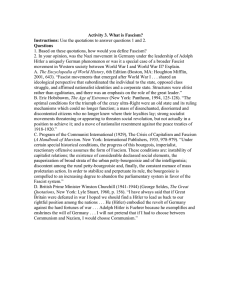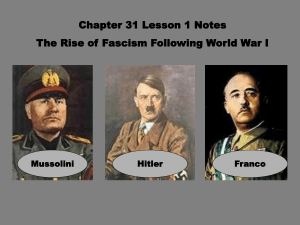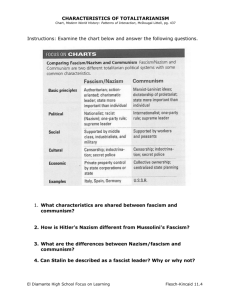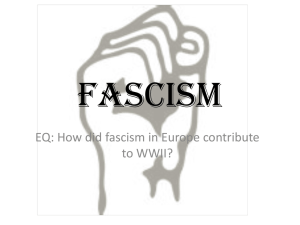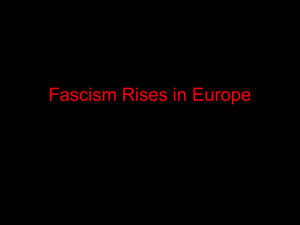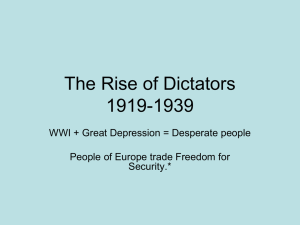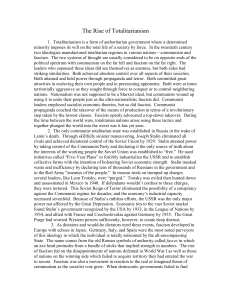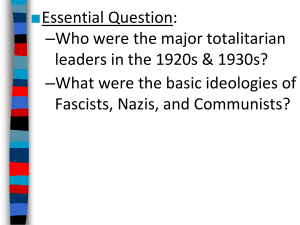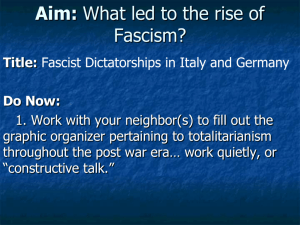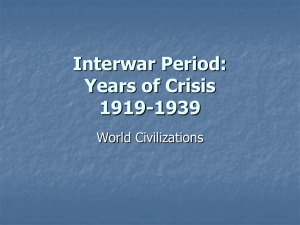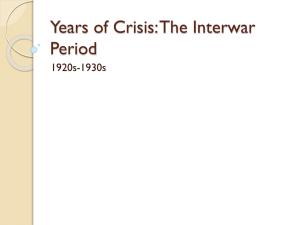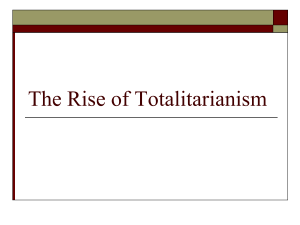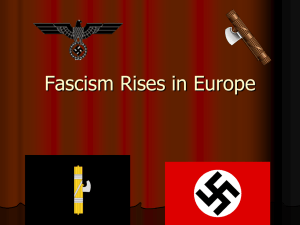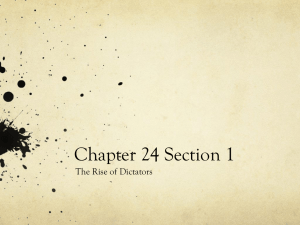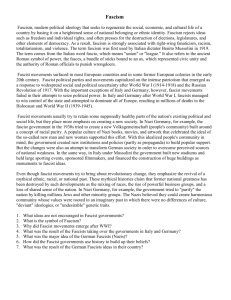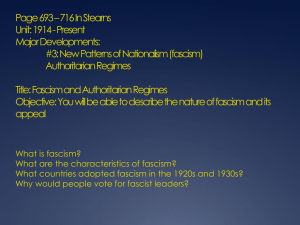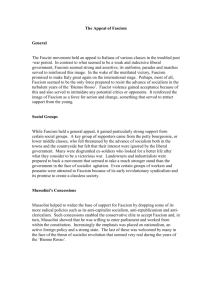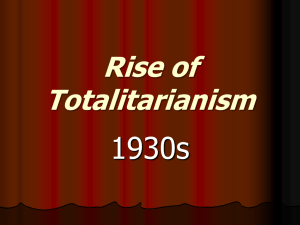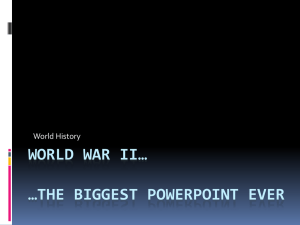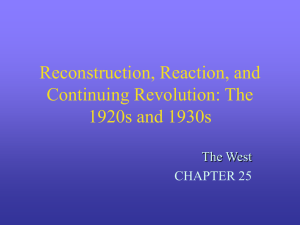TURN YOUR MIND
advertisement
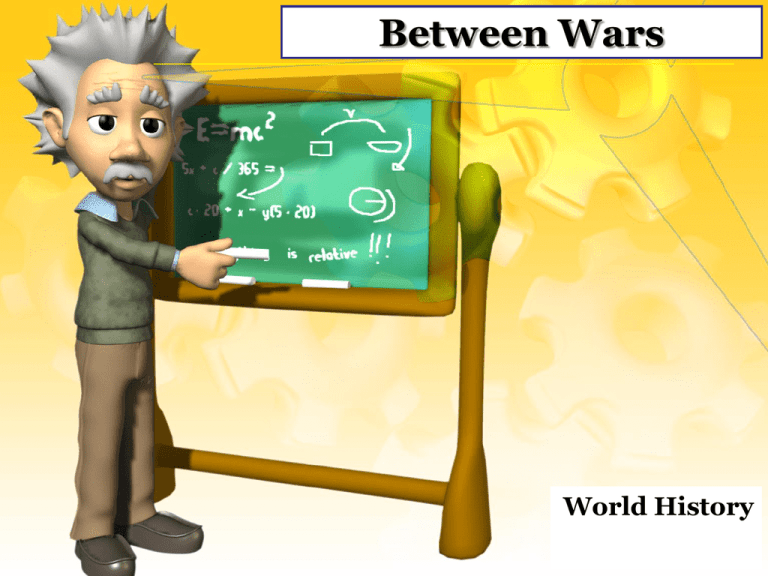
Between Wars World History The postwar period is one of loss and uncertainty but also one of invention, creativity, and new ideas. POSTWAR UNCERTAINTY Revolution in Science Einstein’s Theory of Relativity Radically new ideas in physics Theory of relativity — space and time are not constant Make world seem more uncertain • • • Freudian Psychology New ideas about the mind Claims human behavior not based on reason • • Art & Literature Suffering caused by World War I leads many to doubt old beliefs Thinkers React to Uncertainties Existentialism: no universal meaning to life Surrealism: art movement that links dreams with real life Jazz: music that captures new freedom Women Women take on new roles during World War I right to vote freer clothing hairstyles new careers • • • • Technology Automobile Airplanes • Lindbergh Radio Movies An economic depression in the United States spreads throughout the world and lasts for a decade. A WORLDWIDE DEPRESSION Financial Collapse A Flawed U.S. Economy • Wealth distributed unevenly • People too poor to buy goods • Factory owners cut back on production, lay off workers • Farmers produce more food than people can eat, prices fall • Farmers cannot repay loans and lose their land • The stock market crashes Postwar Europe •Unstable New Democracies •German Inflation •Worldwide Unemployment In response to political turmoil and economic crises, Italy and Germany turn to totalitarian dictators. FASCISM RISES IN EUROPE Fascism Rises • Fascism is a new, militant political movement • Emphasizes nationalism and loyalty to authoritarian leader • Italians want a leader who will take action • Fascist leader, Benito Mussolini, promises to rescue Italy • Italian king puts Mussolini in charge Comparing Fascism to Communism COMMUNISM FASCISM Ruled by: DICTATOR DICTATOR Political Parties ONE ONE Individual Rights Denied Denied Societal Classes None -Classless society Many •Aristocrats •Industrialist •Military •Lower middle class •Workers World View Internationalism -unite workers worldwide National issues take precedence Fascism Rises • Adolf Hitler—obscure political figure in 1920s Germany • Nazism—German brand of fascism 1923 BEER HALL PUTSCH: Hitler tries—but FAILS—to seize power from the democratically elected, but troubled, Weimar Government MEIN KAMPF (My Struggle) : written in jail, Hitler’s book outlines his plan for a Nazi Germany MEIN KAMPF 1.Superiority of German (Aryan) race; all others inferior 2.Jews were the reason for all of Germany’s problems (also Communists) Treaty of Versailles must be overturned Lebensraum: Germany needed “Living Space” for its people (and all lost land returned 3. 4. MEIN KAMPF 5. FURHER Principal: One leader should have supreme power and rule (Rousseau’s “General Will”) Results: Bad economic conditions get Nazi Party elected in growing #’s 1933 Ger. President appoints Hitler Chancellor Burning of Reichstag gives Nazis majority in elections 1.The 17th century was a period of great upheaval in Europe. The decline of feudalism, constant religious and territorial conflicts, and rebellions of overtaxed peasants led monarchs to seek absolute power. *What political and social crises led to the rise of fascism in the 1920s and 1930s? 1.Lack of Democratic tradition: Weimar Government weak 2.Loss of population, houses, factories, farms, schools, hospitals, etc. Loss of “next generation” keeps “old ideas” in power Inflation Trade decreases Personal and Social Anxiety 3. 4. 5. 6. 2. Rulers can increase their power by limiting the power of other institutions. Absolute monarchs of the 1600’s increased their power by limiting the power of the nobility, controlling the Church, creating royal bureaucracies & taking personal control of the central government. How did Fascist leaders increase their own power? 1.Majority control of GOV’T. 2.Allow only 1 PARTY 3. Change Laws: target Jews, newspapers, teachers, political opposition Use of Terror: Assassinations, Prison camps, Threats Secret Police: SS, Gestapo Weakened Cath/Prot. Church Propaganda: massively used 4. 5. 6. 7. 3. Absolute monarchs sought to control economic affairs by giving tax benefits to expand trade and manufacturing and by creating new bureaucracies to control economic life. How did Fascist leaders take command of their countries’ economies? 1.Took over labor unions and outlawed strikes 2.Almost no unemployment: public works, ramped up military, opposition = no jobs Nazis closely regulated private industry State control of prices, production, capital investments, trade, banking 3. 4. 4. In an effort to control every aspect of society and the lives of citizens, absolute monarchs regulated religious worship, social gatherings, and other aspects of daily life. What steps did Fascist leaders take to control the lives of their citizens? 1.Controlled education 2.Youth groups 3.Censorship 4.German women pushed into inferior position 5.Controlled assembly, speech, marriage, occupations, etc. 5. Absolute monarchs believed that the divine right of kings gave them authority to rule with unlimited power. What beliefs or principles did Fascist leaders use to justify their unlimited power? 1. 2. 3. 4. 5. Germany, Italy, and Japan conquer other countries; the rest of the world does nothing to stop them. AGGRESSORS INVADE NATIONS Aggressors March •Britain urges appeasement, a policy of giving in to aggression •Germany, Italy, and Japan—the Axis Powers— form an alliance •United States Follows an Isolationist Policy •Isolationism—avoidance of • political ties with other countries In 1935, Congress passes Neutrality Acts Preserve Peace? •Britain and France again choose • • • • Appeasement, let Hitler take Sudetenland But in 1939, Hitler still takes rest of Czechoslovakia Mussolini takes Albania; Hitler demands part of Poland Nazis and Soviets Sign Nonaggression Pact In 1939, Stalin and Hitler pledge never to attack one another
